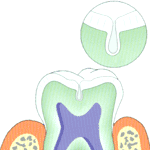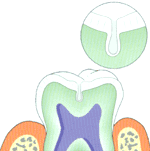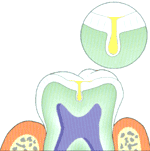| |
 |
| When the fissures or grooves in the back teeth are very deep and narrow, it can be impossible for the bristles of a toothbrush to fit into the fissures to clean them. In cases like this, at Integrated Dentistry, we recommend that the fissures be “Fissure Sealed”. The first step in this process is to ensure that the fissure is free of caries. This is achieved using the Diagnodent and also by painting on “Caries Detector”, a dye that stains caries. This picture shows a fissure, with a “tear-drop” shape, which is open to the mouth and plaque, but is still caries free. The next step is to widen the fissure in order make it possible to fill, and also to ensure that there is no plaque remaining in the space. |
 |
| This picture shows the fissure widened using air abrasion. Occasionally, a small amount of caries is found at this stage, once the fissure has been widened. In these cases, the fissure needs a little more widening with the air abrasion, and the sealant may become a small filling. In any case, there is almost never any need for anaesthetic in these cases. |
 |
| Finally, the cleaned fissure is filled and sealed. The material used is a tooth coloured “composite resin” that bonds to the enamel and dentine (where necessary), as shown here. The purpose of this is to prevent bacteria and plaque from entering into the fissure, and to provide a smooth surface that is easy to clean. The research shows that Fissure Sealing is the most successful measure available for the prevention of caries in fissures of healthy teeth. |
 |
|
 |
|
|



